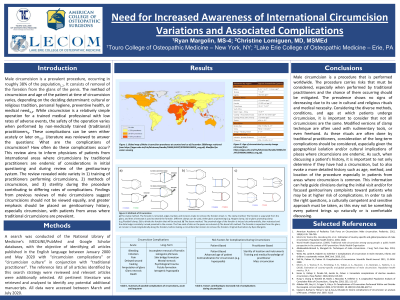Urological Surgery
Need for Increased Awareness of International Circumcision Variations and Associated Complications

Has Audio
Introduction/Purpose: Male circumcision is a prevalent and straightforward procedure. Cultural, religious, and/or social factors impact the decision for circumcision, with method of circumcision and patient age varying accordingly. Safety also varies when performed by non-medically trained (traditional) practitioners, endemic internationally. Complications associated with traditional practitioner performed circumcision warrants further consideration by physicians with patients from international areas. A thorough initial approach with at-risk patients or genitourinary-focused visits can foster open discussion and better understanding of complications attributable to circumcisions.
Methods or Case Description: A systemic literature search yielded 24 manuscripts assessed and incorporated into this review.
Outcomes: Circumcision complications include: bleeding, infection, pain, incomplete foreskin removal, glans amputation, glans necrosis, skin bridge formation, meatal stenosis, or death. Rates vary based on patient age, practitioner training, and method of circumcision. Increased complications are evident from circumcisions after the neonatal period and into adolescence, due to bleeding from increased foreskin vascularity. Cultures which utilize traditional practitioners and untrained volunteers, with varying skill levels, often do not perform circumcisions until a patient has reached adolescence. Surgical settings can vary in equipment and medication availability and sterility. Complication rates from traditional practitioners are difficult to ascertain due to lack of record taking.
Conclusion: Circumcision is a widely performed procedure with risks. Considering varying methods, conditions, and age at which patients undergo circumcision, it is important to emphasize circumcisions are not identical. Heightened clinical suspicion of long-term complications, including meatal stenosis, iatrogenic phimosis, skin bridges, and undesirable appearance, are recommended. When obtaining a clinical history, urologically focused questioning should determine not only if a circumcision was performed but also details, including age, method, and procedure location, to better guide clinicians.
Methods or Case Description: A systemic literature search yielded 24 manuscripts assessed and incorporated into this review.
Outcomes: Circumcision complications include: bleeding, infection, pain, incomplete foreskin removal, glans amputation, glans necrosis, skin bridge formation, meatal stenosis, or death. Rates vary based on patient age, practitioner training, and method of circumcision. Increased complications are evident from circumcisions after the neonatal period and into adolescence, due to bleeding from increased foreskin vascularity. Cultures which utilize traditional practitioners and untrained volunteers, with varying skill levels, often do not perform circumcisions until a patient has reached adolescence. Surgical settings can vary in equipment and medication availability and sterility. Complication rates from traditional practitioners are difficult to ascertain due to lack of record taking.
Conclusion: Circumcision is a widely performed procedure with risks. Considering varying methods, conditions, and age at which patients undergo circumcision, it is important to emphasize circumcisions are not identical. Heightened clinical suspicion of long-term complications, including meatal stenosis, iatrogenic phimosis, skin bridges, and undesirable appearance, are recommended. When obtaining a clinical history, urologically focused questioning should determine not only if a circumcision was performed but also details, including age, method, and procedure location, to better guide clinicians.
.jpg)
Ryan Margolin, OMS-IV
Medical Student
Touro College of Osteopathic Medicine
Weehawken, NJ, US- CL
Christine Lomiguen, MD
Assistant Professor of Pathology & Medical Education
Lake Erie College of Osteopathic Medicine
Erie, PA, US
